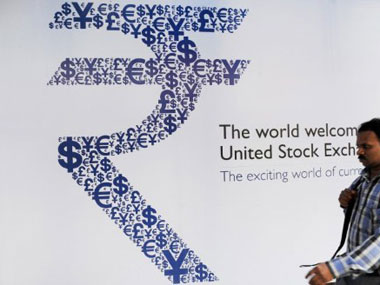The rupee on Wednesday hit a low of 64.52 to the dollar amid investor
scepticism about the policies of the Reserve Bank of India and the Manmohan Singh
government. Traders said the sell-off was intensified by “policy
flip-flops” from the RBI. On Tuesday, the RBI announced that it would
inject over $1 billion into the markets, just days after saying it was
working to tighten liquidity.
There seems to be no respite in sight. Deutsche Bank said it expected
the rupee to touch 70 against the dollar in a month or so. However, it
expects a revival by end of year.
“We continue to believe that fundamentally the rupee is undervalued
and has overshot its equilibrium level substantially, but as numerous
episodes of past currency crises have amply demonstrated, under a
scenario of deep pessimism, currencies can overshoot substantially and
remain so for a long time,” economists at the bank wrote in the report.
The BSE Sensex and the Nifty ended at the lowest close since
September 2012, down about 700 points from the day’s high. While the
Sensex shut shop at 17905, down 340points, the Nifty closed down 98
points at 5302. The Sensex is down more than 7 percent so far this
month.
Here are ten things you need to know about why the currency has depreciated despite RBI measures
• Last week, RBI restricted how much Indian citizens and companies
can invest abroad to reduce pressure on the rupee, while targeting the
current account deficit by banning imports of gold coins and medallions
among other measures.
• The RBI also eased some of the rate limits for deposits targeted at
non-resident Indians (NRIs), though that is also seen as unlikely to
attract inflows in the near term given that NRI deposits have seen net
withdrawals of $1.1 billion in May and June, according to DBS.
• Efficacy of the steps remains in doubt, given outflows have already
been declining this year and that they ultimately do not address the
need to attract overseas investments to narrow a current account deficit
that hit a record 4.8 per cent of gross domestic product in the year
ended in March.
• Instead, traders fear the capital restrictions could adversely
impact company profits and could lead to stronger capital restrictions
that would scare off foreign investors at a time when the expected
tapering of US monetary stimulus is already creating uncertainty in
emerging markets.
• The intensity of the fall is surprising but the fall in itself was
not surprising, said Sanjay Dutt of Quantum Securities. “Some of the
measures taken by the RBI etc, haven’t seemed to have gone down well
with the market participants who feel they are very inward looking and
retrograde in a manner,” he told CNBC-TV18.
• ”The steps taken so far only target residents, but if this raises expectations that they could potentially resort to capital controls
targeted at non-residents, that could have adverse near-term
implications for capital flows,” HSBC’s Chief economist for India and
ASEAN Leif Eskesen said.
“It will, therefore, be critical to tread very carefully when it comes to capital controls,
to anchor expectations, and also not use it as a substitute for more
appropriate and effective measures,” Eskesen said in a note to clients,”
he added.
• A Reuters poll showed short positions in the Indian rupee
have hit the highest in two months amid sustained doubts over
policymakers’ ability to stabilise the currency. Measures to restrict
capital outflows come as overseas investments from India had already
been on the wane, averaging a monthly $400 million in the first half of
the year from $710 million in 2012, according to DBS data.
• To prop up the rupee in the near-term, markets would need
assurances that India can attract foreign flows in an increasingly
difficult global environment. Foreign investors have sold a net $11.6
billion of Indian debt and equities since late May.
• The government has also raised import taxes on gold and silver in
an attempt to narrow the burgeoning current account deficit. The import
duty on gold was hiked to a record 10 percent, the third such increase
in eight months, while duty on silver was hiked from 6 percent to 10
percent. The excise duty on gold bars was hiked to 9 per cent from 7
percent. The hike in duties came after Chidambaram said the government
was looking to contain gold imports at 850 tonnes this fiscal year,
after imports of 950 tonnes last year. However, as Firstpost said earlier, Chidambaram may be forced to introduce more curbs on gold if the 850-tonne limit is to be adhered to.
During the first quarter, global demand for gold fell 12 percent to
856.3 tonnes against 974.6 tonnes in the corresponding period last year.
But in India consumer demand for gold in India jumped 71 percent to 310
tonnes, compared with 181.1 tonnes in the year-ago period despite
repeated increases in import and excise duties by the government this
year.
